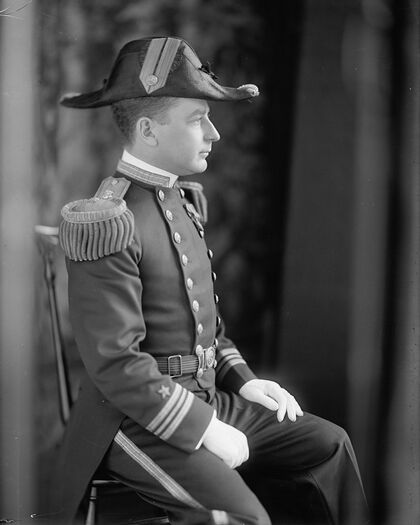WILLIAM F. BRICKER, LCDR, USN
William Bricker '00
Lucky Bag
From the 1900 Lucky Bag:

Bricker, William Franklin
Chambersburg, Pennsylvania
"Hans"
A bright little spoon; "Cherman bandt" : his one ambition, popularity; his one desire, love; his one pastime, the flute; his one hobby, spectacles.
One Striper.
William was also an associate editor of the Lucky Bag.
Loss
William was lost on March 21, 1915 when the rowboat was aboard sank while attempting to return to his ship, USS Scorpion (1896).
From the New York Times on March 23, 1915, via Navsource:
Constantinople, (22 March 1915) Lieut. Commander William F. Bricker of the United States converted yacht Scorpion and three sailors named Ford, Dowell, and Leverings were drowned on the night of March 20 while attempting to reach their vessel in a rowboat. The Scorpion was anchored in the Bosporus off Constantinople, near in Dolma Bagtchi Palace. The rowboat was swamped in a heavy sea thrown up by a south gale. Lieut. Herbert S. Babbitt and one sailor, who were in the boat, were saved. Bricker's body was the only one recovered of the drowning victims. Lieut. Commander Bricker arrived at Constantinople on March 16 to succeed Lieut. Commander Edward McCauley, Jr. in command of the scorpion. New York Times, March 23, 1915
Other Information
From researcher Kathy Franz:
William, known as Frank, graduated from Chambersburg high school in 1895.
During the Spanish American War in the summer of 1898, William was on the cruiser New Orleans in Puerto Rican waters. His brother Edwin was in the infantry at the Battle of El Caney, Cuba; and his brother Mark was enlisted in the 1st U. S. Volunteer Engineers in Puerto Rico. Mark acquired a big screw from the Christobal Colon, a Mauser bullet and three brass ammunition tags bearing Spanish inscriptions.
USS Vulcan tried to tow the abandoned, half-sunk Christobal Colon off the rocks, but she capsized and went under completely. The Naval Battle Underwater Park of Santiago de Cuba has preserved the wreck, and aquatic immersions can be made.
After graduation from the Naval Academy, William was assigned to the Vicksburg and sailed for China. While in Pompeii, he picked a flower resembling a carnation and sent it to his mother with a letter.
In 1904 he was a flag secretary on the Alabama. He then became private secretary to Admiral Davis and sailed with him in December to Paris. At Paris, they were part of the peace commission on the war between Russia and Japan.
In February 1905, the commission reviewed the firing incident on British fishing trawlers by a Russian fleet. In March, William returned to the U. S. and was stationed in Washington, D. C. He then went to New York City.
In January 1910, he transferred from the Vermont to the gunboat Paducah and then sailed for the West Indies. In February 1912, he was on the Georgia at Guantanamo. The next May, he transferred from Naval Intelligence to Naval War College and then to the Navy Department in Washington, D.C.
From October 1914 to February 28, 1915, he was attached to the American Embassy in London.
William's father W. H. was a furniture maker and businessman. His brother Brigadier General Edwin Dyson Navy was an 1898 graduate of West Point. Their other brother was Mark. Their sisters were Mary/Marie E. (Mrs. William L. Maize) and Laura Helen (Mrs. Ralph E. Rearick).
William is buried in Pennsylvania.
Photographs
The "Register of Commissioned and Warrant Officers of the United States Navy and Marine Corps" was published annually from 1815 through at least the 1970s; it provided rank, command or station, and occasionally billet until the beginning of World War II when command/station was no longer included. Scanned copies were reviewed and data entered from the mid-1840s through 1922, when more-frequent Navy Directories were available.
The Navy Directory was a publication that provided information on the command, billet, and rank of every active and retired naval officer. Single editions have been found online from January 1915 and March 1918, and then from three to six editions per year from 1923 through 1940; the final edition is from April 1941.
The entries in both series of documents are sometimes cryptic and confusing. They are often inconsistent, even within an edition, with the name of commands; this is especially true for aviation squadrons in the 1920s and early 1930s.
Alumni listed at the same command may or may not have had significant interactions; they could have shared a stateroom or workspace, stood many hours of watch together… or, especially at the larger commands, they might not have known each other at all. The information provides the opportunity to draw connections that are otherwise invisible, though, and gives a fuller view of the professional experiences of these alumni in Memorial Hall.
January 1901
January 1902
January 1903
January 1904
January 1905
July 1906
July 1907
January 1908
January 1909
January 1910
January 1912
January 1913
January 1914
January 1915

The "category" links below lead to lists of related Honorees; use them to explore further the service and sacrifice of alumni in Memorial Hall.
